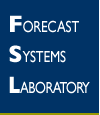| |
Global Atmosphere IN-situ System (GAINS) Project |
| |
|
This project (formerly the Shear-Directed Balloon Project), is developing a long-duration platform, instrumented for environmental sensing through a combination of dropsondes, expendable bathythermographs, in-situ sensors, and remote sensors. Designed as a 110-ft diameter superpressure vehicle carrying a payload of 500 pounds for year-long flights at 65,000 ft, GAINS is targeted to meet NOAA's observing and monitoring mission in the next century. |
| |
Ground-Based GPS IPW Demonstration Network |
| |
|
The Demonstration Division operates and maintains the Ground-Based GPS Water Vapor Demonstration Network, currently consisting of nearly 300 sites located in the contiguous 48 states and Alaska. This observing system measures the integrated (total column) quantity of precipitable water vapor above a fixed site in near real time. This is achieved by partitioning this delay into its wet and dry components. It uses techniques originally developed to correct high precision measurements of very long baselines for applications such as monitoring continental drift. |
|
|
NOAA Profiler Network |
| |
|
The Demonstration Division also manages, operates, and maintains the NOAA Profiler Network, consisting of 35 wind profilers located in the central United States and Alaska. Wind profilers are upward looking, highly sensitive 404 or 449 MHz Doppler radars that can measure the winds above the profiler site. They are specifically designed to measure vertical profiles of horizontal wind speed and direction. |
| |
Quality Control and Monitoring System (QCMS) |
| |
|
This system is being developed by the Systems Development Division - Scientific Applications Group to supply end-users and suppliers of hydrometeorological observations with readily-available quality control information and statistics. |
| |
Regional Radar Volume Project |
| |
|
This project seeks to develop a regional mosaic of WSR-88D data on a 3-dimensional Cartesian grid. Wide-band radar data are used for this mosaic of reflectivity, radial velocity, and derived U and V wind components. The mosaic can be used for display purposes as well as numerical model input. |
| |
Simulation of a Satellite-Borne, Wind-Finding Lidar System |
| |
|
Along with the Environmental Technology Laboratory and the Environmental Modeling Center of NCEP, FSL is participating in a two-year study of the potential impact of a wind-finding lidar that could be flown on a polar orbiting satellite. |
| |
Global Universal Profiling System (GUPS) |
| |
|
A proposed long-term global observing system to improve weather and climate prediction that includes 240 fixed locations over oceans and polar regions and automated aircraft using dropsondes and on-board in-situ instruments. |
| |
|
| |
|
|





